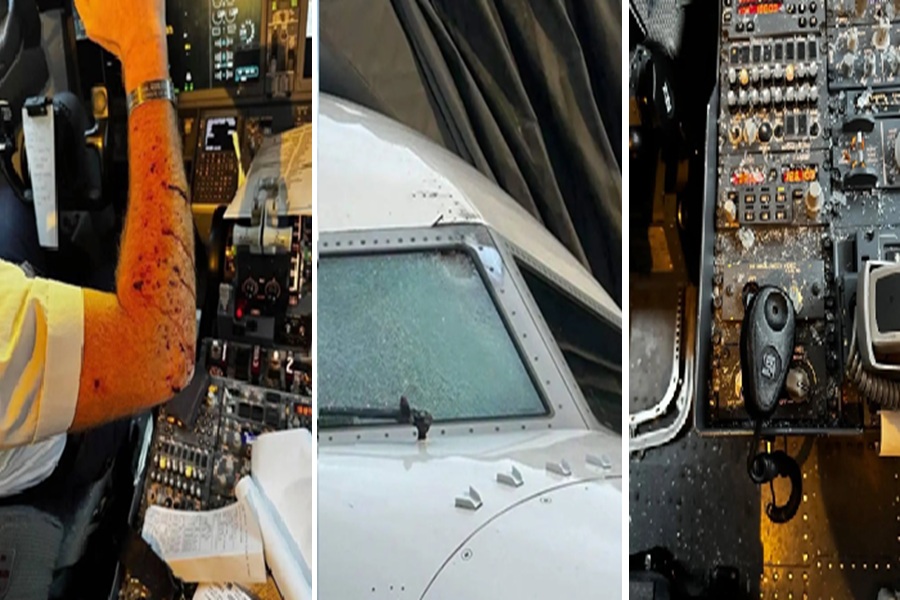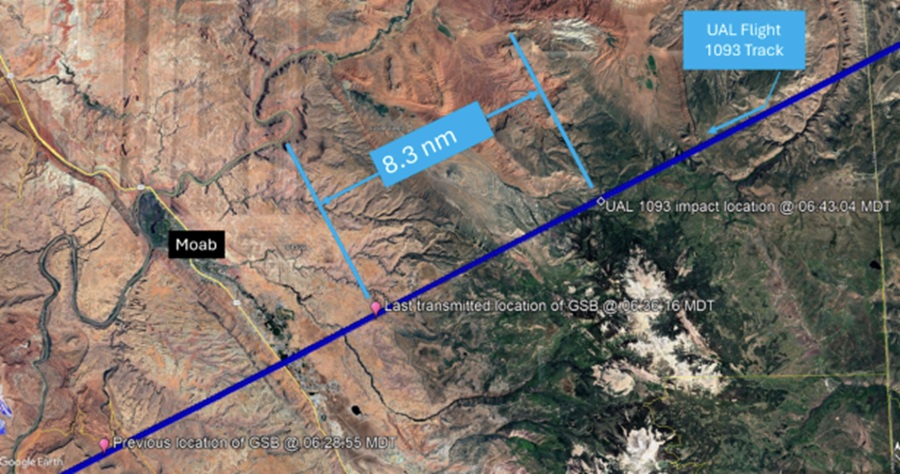
The National Transportation Safety Board (NTSB) has confirmed what the Unidentified Flying Object (UFO) that struck a recent United Airlines jet and injured a pilot is. According to their preliminary report released this week of the October 16 incident, it is likely, as expected, that a weather balloon was the UFO involved in this collision.
On October 16 at 6:43 am local time, United Airlines flight 1093, a Boeing 737-8 collided with an object while in-flight near Moab, Utah. The flight was scheduled to fly from Denver to Los Angeles but was diverted to Salt Lake City after the collision.
According to the NTSB Preliminary Report, the captain, while established in cruise at 36,000 feet, noticed an object distant on the horizon. Before he could mention the object to the first officer in the cockput, there was a significant impact to the first officer’s forward windshield along with a loud bang. The impact resulted in both pilots and the cockpit dashboard being showered with pieces of glass. While the first officer was uninjured, the pilot sustained multiple superficial lacerations to his right arm.

After the event was reported, data was requested for the position of weather balloons, any other aircraft, and for any known reentry objects from space that were large enough to have signification portions survive that might have been in the area of the collision. WindBorne Systems Inc. reported that they lost contact with one of their global sounding balloons (GSBs) that was in the vicinity of the airplane at the time of the accident. The GSB was launched from Spokane, Washington at 11:29 am local time on October 15, 2025. The balloon traveled south from Washington, down through Oregon and Nevada before turning northeast, and was crossing though Utah at the time of the accident.
According to the NTSB, there was a “Notice to Airman”, also known as a NOTAM, alerting pilots of the balloon launch operations at Spokane.
The NTSB report details the balloon believed to have been involved in the incident and technical specifications for the windshield the balloon is thought to have impacted.
The WindBorne GSB system consists of a balloon envelope filled with lift gas, an avionics package for flight control, communications, and sensing, and a ballast system for altitude control. According to Windborne the GSBs are designed with the intent to minimize harm in the event of an impact during flight or landing. No large metal or high-stiffness structural elements are employed. The balloon envelope and the ballast container are a thin, low tensile strength, plastic film. The silica ballast is relatively low density and low grain-size. The lightweight, high-altitude weather balloon operates under the provisions of Title 14 CFR Part 101.1 as an “unmanned free balloon.”

The windshield installed in the involved aircraft was manufactured by PPG Aerospace and was designed to withstand the flight and pressurization loads encountered during flight while providing visibility for the pilots. From outboard to inboard, the windshield consists of a thermally tempered glass pane, a conductive heating film for deice capabilities, a urethane interlayer, a vinyl interlayer, a urethane interlayer, and a thermally tempered glass pane. The windshield is surrounded by a stainless-steel z-bar encased in a moisture seal to attach it to the fuselage. A coating is applied to the outer surface of the outboard pane to improve the ability to shed water in rainy conditions. Windshields are certified to withstand the impact of a four-pound bird without penetration, to be capable of withstanding the maximum cabin pressurization loads with the failure of a single pane, and the internal pane must be non-splintering. The inboard pane of glass is considered a structural pane, the vinyl interlayer is considered a structural fail-safe pane, and the outboard pane of glass is considered a non-structural pane for this design. The damaged right windshield was removed from the airplane and sent to the NTSB Materials Lab in Washington, DC for examination

The flight data and cockpit voice recorders were also sent to the NTSB Vehicle Recorder Laboratory in Washington, DC.
Based on the data from the weather balloon and the aircraft, it is likely the two collided. The last transmitted location of the weather balloon was 8.3 nautical miles away from the impact site and the plane and balloon were moving into the exact opposite direction into each other, with the balloon moving from southwest to northeast and the United flight moving from northeast to southwest.
Shortly after the collision, the CEO of Windborne went on X to share his insights. WindBorne systems CEO and co-founder John Dean saw the images online and wrote on X, “Yes, I think this was a WindBorne balloon. We learned about UA1093 and the potential that it was related to one of our balloons at 11pm PT on Sunday and immediately looked into it. At 6am PT, we sent our preliminary investigation to both NTSB and FAA, and are working with both of them to investigate further.”
According to their website, Windborne writes, “By instrumenting the environment and advancing forecasts, WindBorne is building a planetary nervous system to make the world safer and more sustainable for everyone.”
As part of its business, WindBorne Systems designs, builds, and operates its own weather balloons. It is a company that uses these long-duration, “smart” balloons to collect atmospheric data for agencies like the National Weather Service and partners with organizations such as NOAA, the U.S. Air Force, and the UCSD Scripps Institute of Oceanography. These Global Sounding Balloons (GSBs), which are designed to stay aloft for up to two weeks and operate autonomously. collect detailed atmospheric data and can change altitude in real-time to create vertical profiles of the atmosphere.
Dean wrote on X that his company goes through great lengths to prevent mishaps like this one from happening.
“We file NOTAMs, follow all specifications required by FAA 14 CFR part 101, and share all live balloon positions with the FAA via API and our website…. We have been coordinating with the FAA for the entire history of the company….The system is designed to not pose a risk to human life in the worst case event of a collision. This is what the FAA 101 and ICAO weight limits are for. And indeed, there were no serious injuries and no depressurization event to my knowledge as a result of the collision.”
Dean added, “However, I’m still surprised to see spallation of the windshield on the inside. I find this extremely concerning, and unacceptable in the case of a collision, regardless of what the official regulations are. It resulted in injury to a pilot, which I’m simply not okay with whatsoever.”
“As mentioned, we are working closely with the FAA on this. We haven’t yet received any operational guidance. Regardless, we just deployed a software change to minimize time at active flight levels and are manually checking it across the full constellation. Additionally, we are actively working on new hardware designs to reduce impact force magnitude and concentration.”
We asked Dean how heavy the weather balloon payload is. The payload, which consists of a bag of sand, is roughly the size of a banana. Dean replied to us, “It’s bout 1kg fully loaded with ballast.” 1 kg is roughly 2.2 pounds.
Others on X have lauded Dean for his transparency and openness, including other scientists who have volunteered to improve his company’s technology further to avoid future potential aircraft collisions.
NTSB Chair Jennifer Homendy said last month the incident “could have been really devastating for the aircraft and those on board.”
The NTSB is expected to release their final report in the coming months.